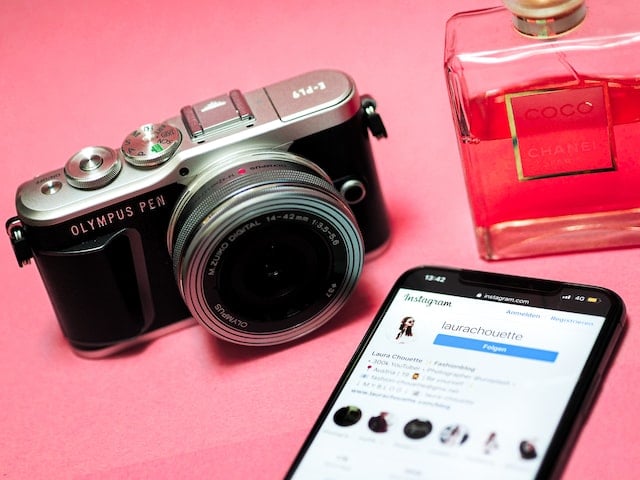These days, influencer marketing is more than just a passing fad. Instead, it has become one of the most important aspects of consumer marketing. Consider the statistics. A whopping 92% of consumers find influencers more trustworthy than celebrities, and 33% of them make purchasing decisions based on influencer recommendations. By contrast, a mere 17% of consumers considered friends and family the most trustworthy when making a purchase.
Of course, the popularity of influencer marketing has been noticed by a large percentage of marketing professionals. In fact, a Shopify survey showed that some 80% of marketers get good ROI from influencer marketing. Because of the effectiveness of this technique, 75% of businesses have a portion of their marketing budget earmarked for influencer marketing.
With all of that said, there’s a lot more to an influencer marketing strategy than just asking a bunch of cool people to give you a shoutout. Here’s what it takes to be successful.
What is influencer marketing in digital marketing?
For a detailed definition check out my video below:
Simply put, influencer marketing is collaborating with other social media users and content creators for relationships of mutual benefit. For brands, the benefits can be one or more of the goals discussed above. Influencers are usually compensated with cash, free product, or both. You’ll base compensation on your goals, the amount of work involved, number of followers, and social network.
The mindset for successful influencer marketing is fostering a long-term, collaborative, win-win relationship. If you have a great influencer marketing strategy, then you’ll attract quality people to work with you. Likewise, working with many of the same influencers long term allows them to know and represent your brand better. This feeds into better outcomes overall.
How do influencers help your marketing?

Having a quality influencer marketing strategy can boost your company’s sales and overall objectives. For example, an influencer can help by:
- Reach a new and often bigger audience. Influencers have a significant following on social media, and they aren’t always the exact people who subscribe to your other advertising channels. In addition, followers can be outside of your specific niche, but become interested in your products.
- Build trust for your product or service. A lot of customers figure that just because your marketing team says something about your products and services doesn’t mean it’s true. However, the word of someone who consumers find trustworthy carries much more weight.
- Grow your following on social media. People who connect with your brand as part of an influencer marketing strategy will also frequently follow your brand on social media.
- Increase traffic to your website. Consumers may want to learn more about what their favorite influencer is talking about. Your website is the best place for that.
- Facilitate lead generation. This can happen by increasing sales, doing a contest, and more. This is part of an influencer’s creativity.
- Increase sales. Remember, recommendations are powerful. And that’s true even if you aren’t also offering promotions through the influencers.
- Help your SEO. Backlinks are very valuable, and depending on the type of influencer content, you can get lots of them. Even without backlinks, you can get more website hits or longer view times, both of which help.
Of course, making your targets through influencer marketing requires them to do some work. Influencers help boost your brand in several ways, many of which should also be part of your influencer marketing strategy:
- Affiliate marketing. This is a way to pay the influencer and drive sales. Here, you give the influencer a special link or code, and pay them whenever these are used to make a purchase. A great way to pay for results.
- Provide an introduction of your product to their community. Simply by discussing your brand or product, the influencer introduces it to their community of social media followers.
- Amplify brand content. Sometimes an influencer will talk about the latest material put out by your company. This tends to look like a shoutout.
- Get creative with content. Co-create or create engaging content that can be leveraged by brands to replace their own content. Or use it to enhance other efforts.
- Co-create products that appeal to the influencer’s community. In the industry, we usually call this a “collaboration” or “collab” for short. These can be everything from limited edition packaging to a complete product design.
- Provide invaluable product and industry feedback. Sometimes it’s great to get feedback from someone outside the company. But it’s even better when the person giving advice has heard from others.
Check out this video for more background on these benefits and an influencer marketing strategy in general:
What is an influencer marketing strategy and what should it include?

Forming an influencer marketing strategy requires that you know what is beneficial for your brand. In many cases, you will want to pursue many of these different goals across different marketing campaigns. And for some campaigns, there can be more than one objective. These will help you design the campaign.
- Brand Awareness: In this case, awareness is knowing about your brand and what it provides.
- Build a Following: Increase the number of people who keep track of your brand. The most common following types are social media followers and email subscribers.
- Generate engagement for your content: Remember, engagement improves your position in most social media algorithms. It is also frequently seen on that person’s feed for even better distribution.
- Content Creation: User generated content is powerful, whether it’s from influencers themselves or the result of their fans creating from their prompts.
- Generate Leads: Landing pages from affiliate links and other tools can get lots of leads.
- Increase Sales: Contests and discount codes are great for this.
- Build More Backlinks: Especially with influencer blog posts and other webpages, there is plenty of opportunity for backlinks.
How will you measure their success? For each of the above objectives, create a way to measure success and architect your influencer marketing campaigns appropriately. One example could be the number of entries to a contest, viewers for video content, or sales from an affiliate campaign. Have a benchmark that represents good performance. These metrics will help you evaluate current influencers and fine tune your influencer marketing strategy.
Further Reading: The Top 25 Influencer Marketing Statistics You Need to Know in 2025
Examples of influencer marketing campaigns
Another consideration when forming your influencer marketing strategy is what kind of campaigns you want to run. While it’s understandable to try just one at first if you’ve never used this technique before, a good influencer program will typically try multiple campaign types.
- Gifting of product in exchange for a mention: This is one of the original campaign types, and it’s really effective for micro influencers and nano influencers. It doesn’t cost much, but it’s easy for them to do too.
- Sponsored content. With this, you’re paying an influencer to mention your product or service in social media or on their blog. These pay a bit more money, but they can also have a greater impact.
- Affiliate marketing. This is often associated by providing an influencer a discount code or affiliate link. Here, you’ll pay a commission or fee per sale.
- Outsourcing content creation or co-creating content with them: Here, you’ll post content they created on your social media channels. Or, the content will be posted on both your channel and theirs.
- Influencer takeover of your account: Your influencer will use your account to share content with their audience. This introduces their people to your brand.
- Co-creating a product with an influencer. Beauty and fashion brands are especially well known for this.
Types of social media influencers

There are many types of people who might be considered social media influencers. Let’s dig into each category.
Who are typical social media influencers?
Social media influencers are often content creators who have built a sizable community around a common topic of interest. They often work with brands as a natural extension of their social media presence.
For instance, bloggers and podcasters discuss what they’re passionate about, but also mention their favorite products. YouTubers are similar, in that they can add a mention of great products in their video. In many cases, for these types of influencers, the sponsorship is an actual commercial. However, affiliate agreements and other campaigns work too.
Social media celebrities are people who make great content on social media and are therefore recognized for their work. In many cases, they’ll talk about their lives. Once someone gets a large enough social media following, they become a type of celebrity.
Authors, industry experts and thought leaders are sought out for what they know or what they run. For instance, Steve Jobs was an industry expert in computing, and much of his work is still celebrated. In other niches such as business, it’s often the thought leaders who control the show, since techniques are often based on theories. And lastly, the authors share knowledge through books. As a result, they become influential in their field.
Influencers by brand affinity.
Let’s also look at influencers in terms of brand affinity. Those without affinity prior to that first collaboration I’ll call an unbranded influencer.
Unbranded influencers
Be careful how much you spend on unbranded influencers, people who may not know you and vice-versa. One of the best ways to blow your influencer marketing budget is by paying too much. And the easiest way to pay too much is to go with an influencer with a large following. For example, if you are in the beauty industry, then one of the biggest influences out there is Kylie Jenner. She has millions of followers and is classed as a mega influencer or celebrity. Want her to pitch your product? Expect to pay more than a million dollars per Instagram post. For long established beauty brands, that might be OK. For a small, niche company, it’s way too much.
Is Your LinkedIn Not Delivering Results?
Just released: my new book to help professionals, entrepreneurs, and business owners maximize LinkedIn for real growth.
With years of LinkedIn expertise, Maximizing LinkedIn for Business Growth offers actionable steps to build your brand, expand your network, and drive results.
Start leveraging LinkedIn like never before—grab your copy now! Click the cover or button below to buy on Amazon.
On the other hand, there are some nano influencers that will work for the price of freebies. A few will charge a little bit more, but as a rule, these influencers are highly effective. This is true, because they still have a lot of passion for what they’re doing. While they’re starting to have a business, it isn’t like their feed is full of a bunch of advertising. Quality tends to be high, and followers are highly engaged. In addition, their prices haven’t gotten very high yet, because they aren’t popular with brands. Best of all, nano influencers can be effective for large and small brands alike.
Between mega influencers and nano influencers, we have micro influencers. These people have several thousand to about 100,000 followers. In many cases, these influencers have a large enough audience to reach a lot of people, but the price is still reasonable.
Branded influencers
Finally, in The Age of Influence, I introduce the concept of focusing on any of the above that have brand affinity for you. Let’s call them branded influencers. These are your Followers, Customers, Partners, and Employees. I call them branded because they already have some relationship with your brand or company, even if only as a follower. In the case of partners or employees, they have a stake in how well your company does. Followers and customers are typically excited and familiar with your brand.
The difference in working with branded vs. unbranded influencers is huge. While you might not get the type of potential impact if you were to work with a social media celebrity, the content that is published by your branded influencers is authentic enough that it doesn’t look like a blatant advertisement to those who see it, making the actual content impactful for those who see it.
Further Reading: The 2 Main Types of Influencers You Need to Know for Effective Influencer Marketing
How to find the right influencers for your brand

Of course, even the best influencer marketing strategy is useless if you can’t find the right influencers to collaborate with. As a general rule, you want someone whose niche appeals to your target audience. For most influencers, the audience should be similar. However, it’s normal for someone to have people outside your target. Here, there’s potential to find a whole new market you didn’t anticipate. However, you also don’t want to pick an influencer with an irrelevant audience.
Start with search
Google, YouTube, social media, your customer database, your email list, your followers, and your employees can all turn up influencers. For searching Google and social media, try using relevant keywords. Then, observe who has a following in your niche. Similarly, followers, email subscribers and employees with a large number of social media followers are potential influencers. The same goes for those who are industry/thought leaders and writers.
Look directly on social media

TikTok is an example of a social media site that has their own creator directory so that you can bypass any 3rd party apps: https://creatormarketplace.tiktok.com/. While they are the only one with this type of open marketplace, look for other social networks to follow suit in the future as they try to lure the creator economy to their platform.
Influencer marketing platforms.
There are influencer marketing discovery tools and marketplaces you can use. Some of them are largely self-service, where you can choose an influencer through multiple search criteria and do most of the work yourself. On the other hand, others keep the majority of interactions on the platform.
Further Reading: Shopify Collabs: The Definitive App for Ecommerce Influencer Marketing
Agencies
You can always hire an agency to help – but they will often use the same tools and platforms mentioned above. With that said, agencies can be convenient, since you do little more than talk about your influencer marketing strategy, approve content, and write a check. If you’re just starting out, it’s an OK but expensive option.
Further Reading: 11 Best Ways to Find Influencers for Your Brand
How to start a conversation with influencers

I have another post where I get into this more extensively, but here are some basics on reaching out to influencers. It’s important to show influencers that you are interested in them before asking for a collaboration so that you can get the best chance of a reply and beneficial treatment – influencers are human beings, after all. About the only exception to this is influencer marketplaces, where influencers are offering their services openly.
Send social signals
First, interact with the influencer’s content. For instance, you might like their picture of the latest family get together. Or their latest crafting technique. Indicate this by liking, commenting, or sharing. This increases their engagement rate and shows you care.
Tell them why you like them

Positive attention from brands, or even followers, helps influencers improve. Show you’re genuinely interested through thoughtful comments. It’ll demonstrate that this person is more to you than a potential pitch.
Slide into the DM (or web contact form)
Influencers are busy people and get contacted by LOTS of brands. If you want to get their attention, show that you contact them via their preferred method, which is most often written directly on their social media profile or contact page on their website.
Don’t just randomly try to slide into the DM at your first opportunity. Only do so after you’ve been engaging with them for some time and hopefully they’ve recognized your engagement! Otherwise, your request can be considered spammy.
How to work and build long-term relationships with social media influencers

Part of any influencer marketing strategy is building lasting relationships with influencers. As a rule, the more any influencer works with your brand, the more invested they can become in your success. And this isn’t only true with employees or partners. Rather, unbranded influencers get a certain enjoyment out of seeing clients succeed. Here’s how to build long term relationships.
First, do you need to pay influencers $$$ at all? Recognition and gifting can go a long way, especially if they already have brand affinity for you. Employers can give a gift card, for instance, or a brand can give something for a review. This tends to be inexpensive, but it works best for nano or micro influencers.
Second, have an influencer agreement in place. This outlines what you expect the influencer to do, and how you intend to compensate them. In addition, you’ll want to specify what level of content approval you require.
Third, make sure that the activities you and the influencer agree on are aligned with your strategy. One of the worst things you can do is have mismatched goals. It’s a great way to get content that you can’t use or that is less effective, and that you have to pay for. In addition, you need to safeguard your brand from rogue influencers.
Further Reading: Influencer Marketing Best Practices: How to Build Successful Partnerships
Track your influencer marketing ROI
Once you’ve finished a campaign, it’s time to measure performance of each influencer and how they contributed to your campaign objectives. Your criteria for success will depend on the campaign goals, and where the campaign fits into your influencer marketing strategy. For instance, the number of impressions, likes, or sales.
Once you have data, you create a baseline and realize which influencers deliver great ROI. It’s always good to experiment with new influencers to see if they can outperform your average, always increasing the effectiveness of your influencer marketing strategy. After all, a fresh face helps introduce your brand to new people as the audience changes.
Finally, it’s sometimes necessary to cut people from your influencer marketing program. Some people aren’t good at selling things, even if they have a lot of followers. Or, they might not be getting a good enough ROI. Remember, as important as personal relationships are, it’s still a business decision.
Further Reading: Influencer Marketing ROI: The Ultimate Guide to Measuring It the Right Way
Selected Influencer Marketing Tools of the Trade
Finally, I’d like to look at the different kinds of influencer marketing tools. These help you make your influencer marketing strategy go from theory into reality. Since I have an extensive post that describes individual tools, I’ll give an overview of tool types here.
Social listening tools
These are useful for many different aspects of social media marketing. Listening tools look for your brand across social media, then report the results to you. So, if a creator talks about your brand, you’ll see this on your reports. In many cases, this will help you find influencers. It’s also a great way to monitor campaign effectiveness.
Blogger outreach tools
A blogger outreach tool will monitor blogs in your niche or topic, then show who is talking about your kind of product. Or for certain niches, the overall subjects relevant to your products. Then, you can reach out to the right people in the right place to get a collaboration.
Influencer discovery tools
This kind of tool does what it says: help find influencers. The scope of most searches includes both bloggers and social media creators. Discovery tools are a great shortcut when extensive searches aren’t an option. Plus, they’ll look in multiple places faster, saving time.
Ecommerce influencer tools
These are discovery tools with an ecommerce emphasis. In particular, they’ll comb through your email and customer lists, in addition to standard social media searches. The idea is to find people who already have brand affinity or help sell your kind of products.
Influencer marketplaces
Also called influencer platforms, these tools are a place to go and meet influencers. Depending on the type of marketplace, there are different levels of collaboration available on the site. For instance, some primarily facilitate meetups, while others handle most of the transaction.
Influencer marketing agencies
Finally, there are influencer tools where you do little work other than paying the bill. Here, the agency will select an influencer for you based on your influencer marketing strategy, niche, and budget. If you’re a busy marketer trying to do everything at once, they can be a godsend.
Further Reading: Your Guide to the 67 Best Influencer Marketing Tools to Empower Your 2025 Digital Marketing
Ready to create your own influencer marketing strategy now?
In an age where in-person contact is minimized, and where people are desensitized to traditional marketing. Influencer collaborations are more important than ever. However, like other types of marketing, an influencer marketing strategy is critical for success. Fortunately, by following this guide and related articles on my website, you’ll get a good foundation for what it takes to succeed.
There is no cookie cutter approach to creating an influencer marketing strategy that delivers high ROI. Hopefully the above advice helps you craft or optimize your strategy. For more advice, check out my book The Age of Influence or download a free preview here.
Hero photo by Clayton Cardinalli on Unsplash













Hi Neal,
Thanks for the amazing content. I appreciate your effort in this. I agree with you Social platforms like facebook or twitter were once used for communicating only but now these platforms are developing gradually and we need to flow with the change to continue. We should always cope up with the current situation prevailing like- it’s a pandemic going on. We need to attract audiences by certain things they need during this period. Social influencers play quite a good role in marketing on social platforms. I would like to hear more from you on which social platform is best to hire social influencers to advertise our product.
Thanks for the comment Michael. And the answer to your question depends on what you are looking for from the influencer, where your target audience is in social media, etc. No easy answer!